#and texture sizes are often overlooked
Explore tagged Tumblr posts
Text



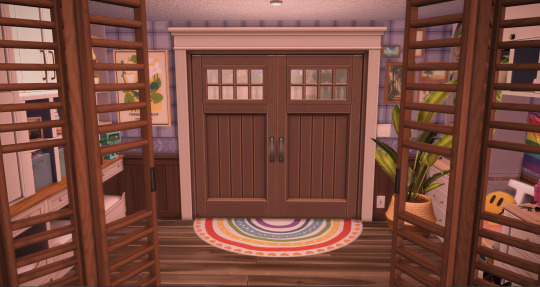





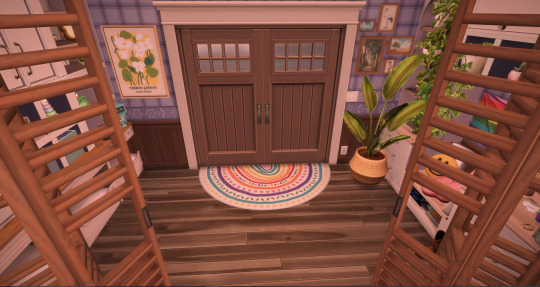
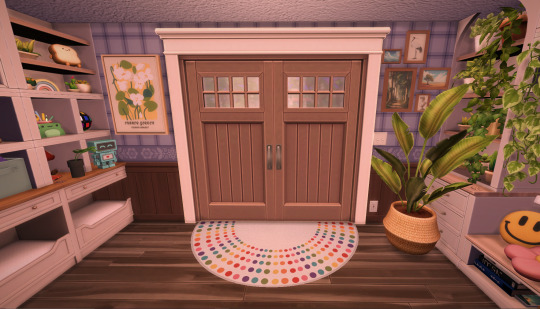
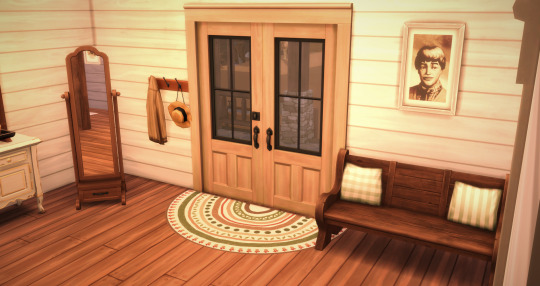

Donut Co. Rainboho-tastic - Halfway There Rugs 📢 Simmers, Are Your Sims STILL Stepping Onto Snore-fest Rugs?! 😴 (We're Looking at You, EA!) 📢
Let's be real, folks. Finding decent rugs in the Sims 4 is like searching for a unicorn in a haystack. You spend hours scouring the build catalog, only to be greeted by a sea of beige, blah, and just plain BORING. 😫
And don't even get us started on the elusive "half rug." Seriously, EA, where are they hiding? Did they get lost in a time portal? Are they being held hostage by a rogue pack of Build Mode gnomes? We need more options! 😤
But fear not, fellow decorators! Donut Co. is here to rescue your Sims' floors (and your sanity!) with our Rainboho-tastic - Halfway There Rugs! ✨
These aren't your grandma's rugs, folks. We're talking vibrant, playful masterpieces that'll make your Sims want to ditch their shoes and do a happy dance! 💃
🌈 A Rainbow of Possibilities:
Whimsical Rainbows: Step into a world of color with our signature rainbow arch designs.
Playful Rubber Duckies: Add a touch of whimsy to your Sims' bathrooms (because who doesn't love a rubber ducky serenade in the shower?).
Blooming Leaves: Bring the beauty of nature indoors (without the risk of your Sims forgetting to water them... again).
Enchanted Mushrooms: Step into a fairytale with these whimsical mushroom designs (no, they won't make your Sims trip out... we think).
Unique Designs: For those who love a touch of abstract flair (and maybe a little mystery).
✨ Why You'll Love Them:
Perfect for Entryways & Bathrooms: Finally, a rug that's the perfect size for those often-overlooked spaces! No more awkwardly oversized rugs in your tiny bathrooms!
Plush & Comfy: Your Sims will love sinking their toes into these soft, inviting textures (it's like walking on a cloud... but without the fear of falling through).
Vibrant & Playful: Add a pop of personality and charm to any room (because let's face it, beige is SO last century).
So, ditch those snooze-fest bath mats and welcome your Sims home with a burst of color and comfort! Donut Co.'s Rainboho-tastic - Halfway There Rugs are here to transform your Sims' homes into havens of style and personality. ~~~~~~~~~~~~~~ GUYS - A friend of mine saw my rugs while WIP and has decided to make some wallpapers to go along with them - Using my png files!! So they will match exactly to these rugs! They're already a wonderful cc creator - so you should definitely check them out; but be sure to watch out for the wallpapers coming really soon! Xx (They look amazing already!!!!) Find them here: https://crimsonrozes.tumblr.com/ ~~~~~~~~~~~~~~ All images have my reshade on - You can find no reshade images on the patreon and curseforge posts!*** If you are interested in my reshade, or want to see how much it changes the color - you can find it here: https://www.tumblr.com/noideabutsims/763209634729345024/remember-those-days-reshade-preset-guess-what?source=share ~~~~~~~~~~~~~~ Has 17 swatches New mesh
All of our CC can be found by typing " Donut " into the search bar! Name: Donut Co. Rainboho-tastic - Halfway There Rugs Buy Mode Description: "Add a splash of personality to your Sims' entryways and bathrooms with Donut Co.'s Rainboho-tastic - Halfway There Rugs! These vibrant creations blend playful patterns and eye-catching colors to transform those often-overlooked spaces.
Imagine your Sims stepping onto a plush rainbow archway as they enter their home, or sinking their toes into a cloud of softness after a relaxing bath. With whimsical rainbows, playful rubber duckies, blooming florals, enchanting mushrooms, and unique rainbow swirls, there's a design for every style.
So ditch those boring bath mats and welcome your Sims home with a burst of color and comfort!
Woah-oh - You're halfway there - to having the best rugs in town! XD" Will be releasing more content soon! stay tuned! ❤️ (NOT affiliated with EA or Maxis in any way! We just make CC!) ~~~~~~~~~~~~~~~~~ DOWNLOAD: Curseforge: https://legacy.curseforge.com/sims4/build-buy/donut-co-rainboho-tastic-halfway-there-rugs Patreon: https://www.patreon.com/posts/116930384 Google Drive: https://drive.google.com/file/d/1MF3sWv5ZzL10PgM_kNZZ6pJZfN5hhIPe/view?usp=sharing ~~~~~~~~~~~~~~~~~~ Due to financial issues and our promise of never paywalling our content; We have to ask that you guys download on our curseforge if you are willing and able. Just using their site to download makes us be able to have at least a small income that helps us when things get tough - however no matter where you download; we genuinely appreciate every download regardless!! If you can, you can find our curseforge here!: https://legacy.curseforge.com/members/the_lady_gaia/projects
Download it today and let the color explosion begin! 🌈✨ @alwaysfreecc @maxismatchccworld
#sims#mysimscc#sims 4 maxis match#sims 4 cc#always free cc#noideabutsims#patreon#ts4#sims 4 custom content#simblr#buildbuy#sims 4#my cc#cc finds#free cc#cccc#ts4 cc#the sims cc#cc#ts4 cc free#sims 4 cc free#sims cc free#freecc#ts4 custom content#ts4cc#ts4 maxis match#maxismatch#sims maxis match#maxis match cc#maxis match
60 notes
·
View notes
Text
Customizable Hotel Bedding Supplies: How USA Suppliers Help Hotels Stand Out
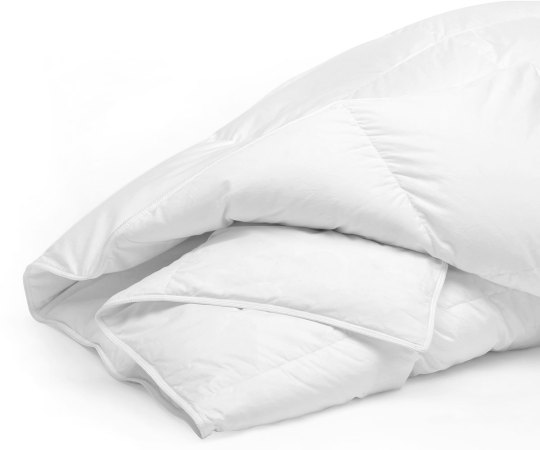
Introduction
In today’s competitive hospitality industry, creating a unique guest experience is key to standing out. One often overlooked yet powerful way hotels achieve this is through customizable hotel bedding supplies. USA suppliers are stepping up to provide tailored solutions that align with a hotel’s brand identity, enhance guest comfort, and leave lasting impressions. Here’s how customization is reshaping the landscape of hotel bedding supplies in the USA.
1. The Power of Personalization in Hospitality
Guests today expect more than a comfortable bed—they want an experience that feels uniquely theirs. Customizable bedding supplies allow hotels to deliver on this expectation by incorporating elements that reflect their brand identity. From monogrammed pillowcases to unique color schemes that match the hotel’s aesthetic, personalized bedding makes a statement. This attention to detail not only enhances the guest experience but also fosters brand loyalty and positive reviews.
2. Branded Linens as a Marketing Tool
USA-based hotel bedding suppliers are increasingly offering options for branding linens with hotel logos, slogans, or designs. This subtle yet impactful customization reinforces the hotel’s image and creates a cohesive look across rooms. When guests share photos of their stays on social media, branded bedding becomes a silent ambassador for the hotel, amplifying its marketing efforts and visibility.
3. Custom Sizes and Materials for Unique Needs
Hotels with distinct room layouts or specific guest demographics often require bedding that deviates from standard dimensions or materials. USA suppliers cater to these needs by offering custom sizes and fabric choices, such as hypoallergenic or organic options. This flexibility ensures that hotels can provide bedding that meets their unique requirements, further enhancing guest satisfaction and differentiating themselves from competitors.
4. Elevating Luxury with Exclusive Designs
For high-end hotels, luxury is all about exclusivity. USA wholesale suppliers are helping these establishments stand out by offering exclusive designs, such as embroidered patterns or high-thread-count sheets in bespoke textures. These luxurious touches elevate the guest experience, making it memorable and aligned with the expectations of premium clientele.
5. Sustainability and Customization: A Winning Combination
As sustainability becomes a priority for travelers, many hotels are looking for bedding options that reflect their commitment to the environment. USA suppliers now offer customizable eco-friendly bedding solutions, such as linens made from organic cotton or recycled materials. By combining sustainability with personalization, hotels can appeal to eco-conscious guests while maintaining a unique identity.
6. Cost-Effective Solutions for Every Budget
Contrary to the perception that customization is expensive, many USA suppliers offer cost-effective solutions that suit various budgets. Whether it’s adding subtle branding to standard bedding or creating entirely bespoke designs, hotels can find customizable options that balance quality and affordability. These solutions allow hotels of all sizes to differentiate themselves without breaking the bank.
Customization: The Key to Hospitality Excellence
Customizable hotel bedding supplies are more than a luxury—they’re a strategic tool for standing out in the crowded hospitality market. USA suppliers are empowering hotels with tailored solutions that enhance comfort, reflect brand identity, and cater to modern guest expectations. By investing in personalized bedding, hotels not only elevate the guest experience but also position themselves as memorable, forward-thinking establishments. As customization becomes the norm, hotels that embrace this trend will set themselves apart as leaders in the industry.
2 notes
·
View notes
Text
What is a Scalpel Handle Used For?
Scalpel handles are one of the essential tools in the medical field, crucial for facilitating a wide range of surgical procedures. Understanding what a scalpel handle is used for allows us to see how its design, ergonomics, and compatibility with various blades play a vital role in surgical precision, control, and safety. This article will explore every facet of the surgical scalpel handle, from its types and functions to applications in different medical fields, to help medical practitioners make informed choices about this important instrument.
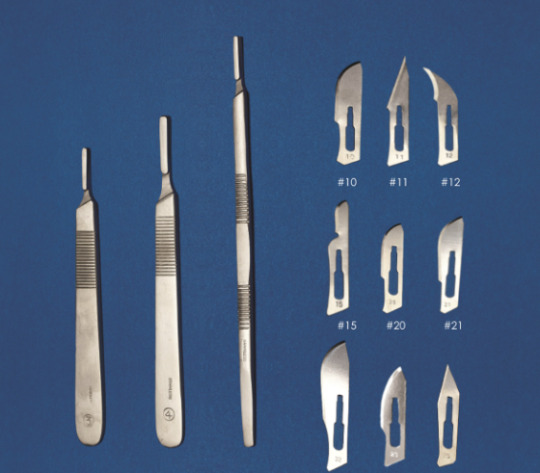
1. What is a Scalpel Handle?
A surgical scalpel handle is the component of a scalpel that provides the base for attaching a surgical blade. While it may look simple, the scalpel handle is meticulously designed to offer comfort and stability, ensuring the surgeon can make precise cuts without experiencing hand fatigue. This handle serves as the grip for the scalpel, which can then be equipped with various blades tailored to different surgical procedures.
The scalpel handle and blade function together as a single unit to create a controlled cutting tool. Often overlooked, the handle plays a significant role in determining how comfortable and stable the scalpel feels during delicate procedures. With numerous sizes, materials, and designs available, each scalpel handle serves a unique purpose in different medical settings, illustrating how crucial it is to know what a scalpel handle is used for.
2. Types of Scalpel Handles
Scalpel handles vary widely to accommodate different surgical applications, blade types, and user preferences. Here’s a breakdown of the major types:
Disposable vs. Reusable Scalpel Handles: Disposable scalpel handles come with a blade attached and are discarded after a single use. They are cost-effective for procedures that don’t require high precision. Reusable handles are typically made from materials like stainless steel, which can be sterilized and reused, making them ideal for surgeries that require utmost precision and flexibility in blade types.
Material Types: Scalpel handles can be made from stainless steel, plastic, or other durable materials. Stainless steel handles are sturdy and provide excellent control, whereas plastic handles are lightweight, cost-effective, and disposable. Metal handles are preferred for high-stakes surgeries where precision is paramount.
Size and Weight Variations: Different sizes are available, such as no. 3, no. 4, and no. 7, which cater to various blade types and surgical procedures. Heavier handles provide greater stability, while lighter handles allow for quick, delicate movements. Understanding these variations helps medical professionals determine exactly what a scalpel handle is used for in various procedures.
Specialized Scalpel Handles: Certain handles are tailored to specific disciplines, such as dermatology and podiatry. For example, podiatry scalpels may feature ergonomic designs for comfortable handling during foot surgeries. Specialized scalpel handles ensure that medical professionals have the right tool for specific areas of the body, further illustrating the importance of knowing what a scalpel handle is used for.
3. Functions of a Scalpel Handle in Surgical Procedures
The primary function of a scalpel handle is to provide a stable, ergonomic base for the surgical blade. Here’s how scalpel handles contribute to successful procedures:
Precision and Control: A well-designed handle enhances the surgeon’s control, allowing for precise cuts. This control is especially vital in surgeries that require exact incisions, such as vascular surgery.
Grip and Stability: Scalpel handles are designed with textured grips that prevent slipping, even in conditions involving moisture or blood. This secure grip allows the surgeon to maintain a steady hand, which is critical for precise and safe cuts.
Blade Positioning: A scalpel handle enables specific blade angles, allowing surgeons to adjust their approach to the target tissue. Knowing what a scalpel handle is used for in terms of positioning helps surgeons align the blade accurately.
Ergonomic Comfort: Surgical procedures can be lengthy, and a well-designed handle helps reduce hand fatigue. The ergonomic design also ensures surgeons can maintain stability and control over extended periods, crucial for procedures requiring prolonged focus.
4. Choosing the Right Scalpel Handle for Specific Procedures
Selecting the correct scalpel handle is essential, as each handle type serves a unique purpose. Here’s a guide on what to consider when determining what scalpel handle is used for in specific procedures:
Handle Size: Different sizes provide various levels of control. Smaller handles (no. 3) are ideal for delicate surgeries, while larger handles (no. 4) work best for deep incisions.
Material and Comfort: Stainless steel handles are recommended for surgeries requiring precision, while plastic handles can be sufficient for disposable, single-use applications.
Blade Compatibility: Certain handles are compatible with specific blade types, so it’s essential to match the handle to the blade required for a procedure. This ensures the scalpel is both safe and effective.
5. Applications of Scalpel Handles Across Different Medical Fields
Scalpel handles have unique applications depending on the medical field:
General Surgery: Common handle sizes such as no. 3 or no. 4 are used with blades designed for abdominal and vascular surgeries. These handle types provide the stability and control needed for intricate procedures.
Podiatry: Specialized scalpel handles are designed for foot-related procedures, offering ergonomic support to prevent hand fatigue.
Dermatology: Dermatological surgeries involve precise, shallow incisions, making lightweight, small scalpel handles ideal. Such handles allow dermatologists to make gentle cuts without exerting excessive force.
Veterinary Medicine: Veterinary surgeries often require versatile scalpel handles that can support different blade types, given the variation in animal anatomy and tissue types.
Dental Surgery: Oral surgeries require compact scalpel handles that enable maneuverability in confined spaces.
Laboratory and Autopsy Applications: In dissections and autopsies, scalpel handles provide the stability necessary for detailed tissue examination and educational purposes.
6. Safety Measures and Best Practices for Using Scalpel Handles
Understanding what a scalpel handle is used for includes knowing proper safety protocols:
Proper Handling: Use a firm but not excessively tight grip to maintain control without straining the hand.
Blade Attachment and Removal: Always attach and remove blades with a tool to avoid direct contact, reducing the risk of accidental cuts.
Safety Features: Many handles now come with locking mechanisms and retractable designs to minimize the risk of injury.
7. Maintenance and Sterilization of Scalpel Handles
To ensure long-lasting use, scalpel handles require proper cleaning, sterilization, and maintenance.
Cleaning Procedures: Reusable handles should be rinsed immediately after use to prevent the buildup of biological material. Proper cleaning is essential for preventing cross-contamination.
Sterilization Techniques: Autoclaving is commonly used to sterilize stainless steel handles, while disposable handles should be discarded according to biohazard protocols.
Inspection and Storage: Regularly inspect reusable scalpel handles for any signs of wear. Store them in sterilized conditions to maintain their quality and readiness for future procedures.
8. Frequently Asked Questions about Scalpel Handles
What is the best material for a scalpel handle? Stainless steel is often preferred for its durability and ease of sterilization.
How do I know which scalpel handle size to use? The procedure and blade type guide the choice. Larger handles are generally for deep incisions, while smaller ones are for delicate work.
Are disposable handles as effective as reusable ones? Disposable handles are cost-effective and ideal for simpler procedures, but reusable stainless steel handles offer better precision and control.
9. Conclusion
Knowing what a scalpel handle is used for allows medical professionals to maximize their efficiency and safety in surgeries. With options available in material, size, and specialty design, the scalpel handle is indispensable to a surgeon’s toolkit, adapting to a range of medical and surgical requirements. Informed selection of a scalpel handle impacts the precision, control, and comfort a surgeon experiences, demonstrating its essential role in modern healthcare.
2 notes
·
View notes
Text
Discover Luxurious Comfort: Shop the Best Bed Sheets Online
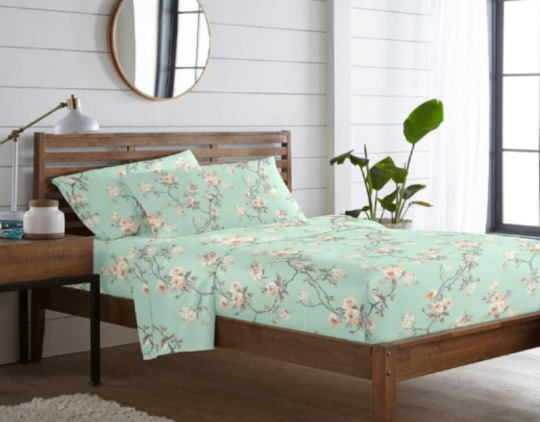
There’s no better way to enhance your sleep experience than with the right set of bed sheets. From their texture to their quality, bed sheets play a crucial role in how comfortable you feel in your bedroom. With the convenience of shopping for bed sheets online, finding the perfect combination of style, comfort, and durability has never been easier. Whether you prefer crisp cotton, soft linen, or elegant satin, the right bed sheets can transform not only your sleep but also the overall aesthetic of your bedroom.
In this blog, we’ll explore why investing in quality bed sheets is essential, what to consider when shopping for them, and how to pick the perfect set online.
1. Why do High-Quality Bed Sheets Matter?
When it comes to creating a peaceful and restful sleep environment, bed sheets are one of the most important yet often overlooked aspects. Poor-quality sheets can lead to discomfort, sleepless nights, and even skin irritation, while high-quality sheets make your bed a haven of relaxation. Good bed sheets provide:
Better sleep quality: Soft and breathable sheets help regulate body temperature and ensure a comfortable night’s sleep. No one wants to wake up sweating or feeling too cold in the middle of the night, and the right sheets can prevent that from happening.
Durability: High-quality sheets tend to last longer, resisting wear and tear from regular use and washing. This means fewer replacements and better long-term value.
Aesthetic appeal: Bed sheets do more than just protect your mattress. They add a touch of style and elegance to your bedroom. By choosing the right colors and patterns, you can enhance the overall décor of your space.
2. What to Consider When Shopping for Bed Sheets Online?
Before you dive into the world of bed sheets online, it’s essential to understand the key factors that determine quality and comfort. Here are some of the elements to keep in mind before purchasing:
Fabric Material
The fabric you choose has a direct impact on how the bed sheets feel against your skin. Some common fabrics include:
Cotton: Known for its softness, breathability, and durability, cotton is the most popular choice for bed sheets. Egyptian cotton and Pima cotton are top-quality options that provide a luxurious feel.
Linen: Linen fabrics are highly breathable and perfect for warmer climates. They have a textured, natural look and become softer with each wash.
Satin: If you want a silky, smooth finish, satin sheets are a great option. These sheets add a touch of elegance and are perfect for creating a luxurious atmosphere.
Microfiber: Affordable and lightweight, microfiber sheets are durable and resistant to wrinkles. However, this microfiber is not as breathable as natural fibers.
Thread Count
Thread count is referred to as the number of threads woven into one square inch of fabric. While many people believe that a higher thread count automatically means better quality, that’s not always the case. A thread count between 300 and 600 is often considered ideal for soft and durable sheets. However, the type of fabric and how it’s woven can be more important than thread count alone.
Size and Fit
To avoid the frustration of ill-fitting sheets, ensure that you know the exact dimensions of your mattress before shopping for bed sheets online. Whether you have a twin, queen, or king-sized bed, it's crucial to find sheets that fit snugly without slipping off during the night. Look for sheets with deep pockets if you have a thicker mattress or use a mattress topper.
Design and Color
Bed sheets come in a variety of patterns, colors, and designs. Whether you prefer solid colors for a minimalist look or intricate patterns to add some personality, there are endless options to match your style. Neutral tones like white, gray, and beige are timeless choices, while bold colors and prints can create a statement.
3. Shopping for Bed Sheets Online: Tips and Tricks
With so many options available, buying bed sheets online can feel overwhelming. Ensure you make the right choice with the following tips:
Read Reviews
Customer reviews are invaluable when it comes to shopping online. They provide real insights into the quality, feel, and durability of the sheets. Pay attention to feedback on fabric softness, washability, and fit to make an informed decision.
Check the Return Policy
While online shopping offers convenience, it’s essential to check the return policy of the store before making a purchase. Ensure that the store offers easy returns or exchanges in case the sheets don’t meet your expectations or don’t fit your mattress properly.
Look for Discounts and Offers
Many online stores offer seasonal discounts, sales, or bundled offers on bed sheets. Be sure to keep an eye out for these deals to get the best value for your money without compromising on quality.
Stick to Trusted Brands
When buying bed sheets online, it’s a good idea to stick to reputable brands that are known for their quality products. This ensures that you’re investing in sheets that will provide comfort and last long, giving you peace of mind.
4. Elevate Your Bedroom with the Perfect Bed Sheets
By investing in high-quality bed sheets, you can elevate your bedroom's comfort and style. Whether you prefer the crispness of cotton, the luxury of satin, or the breeziness of linen, the right bed sheets will make a world of difference in how well you sleep and how your bedroom looks. And with the convenience of shopping for bed sheets online, you can easily find the perfect set to suit your needs and preferences without leaving the comfort of your home.
So why wait? Upgrade your bedroom with luxurious, high-quality bed sheets that will make every night a restful and rejuvenating experience. Browse through a wide selection of styles, fabrics, and colors online, and transform your sleep environment today!
Visit our website: https://vaaree.com/collections/bedsheets
Keywords: #bed_sheets_online, #bed_sheets
2 notes
·
View notes
Text
The Legend of Zelda: Ocarina of Time


JP release: 21th November 1998
NA release: 23rd November 1998
PAL release: 11th December 1998
Developer: Nintendo
Publisher: Nintendo
N64 Magazine Score: 98%

Often heralded as one of the greatest games of all time, I really don’t need to go into great detail as to what makes Ocarina of Time so amazing, as it provided one of the first epic adventures in 3D in a way that felt real. For this, I played a fan made PC port of the game that is a very faithful recreation. I used a few enhancements, such as camera control and the ability to assign items to the D-pad, plus a texture pack which added detail but still kept the feel of the N64 original.

The game starts out in Kokiri Forest, which serves as a tutorial hub that manages to not feel like a tutorial. This is a small playground that lets you play with aspects of the game’s control and targeting systems, the context sensitive A-button, but all the lessons are completely optional and are for the player to find. This kind of discovery was a great feeling as a kid, and the starting area is designed in such a way that if you know what you’re doing, you can very quickly grab your sword and shield and get on with the game.
I feel like Kokiri Forest is overlooked for how well it introduces Ocarina of Time, as a lot of the stuff is now just second nature in video games, but Ocarina had to teach everything from scratch. Even simple things like pots respawning to collect more rupees is taught by the rarity of rupees and the need to buy the Deku Shield, and the little pond areas introduce how jumping is done in the game.
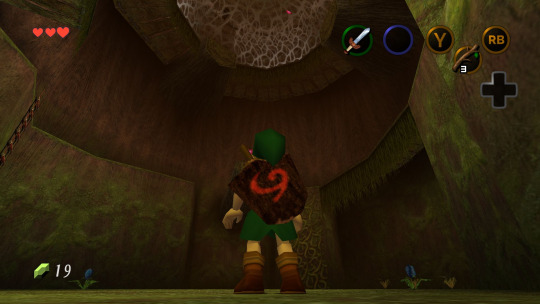
Dungeons are a big part of Ocarina of Time, and the game eases you into them with the Deku Tree, while also showing off the verticality possible thanks to the N64’s power. There are a few little tricks like trapping you in the slingshot room until you use it. Unfortunately, Navi does decide to butt in by explaining specific actions like moving blocks and diving, running the freedom of the starting village, but as you the action for interacting with a block changes based on if you’re still and moving, I can see people missing one of the actions and getting stuck.
The game directs you upwards to perform a big jump to get to the lower areas of the tree, and uses deku sticks to activate torches and remove obstacles, showing the kind of ways that you can interact with in the game.
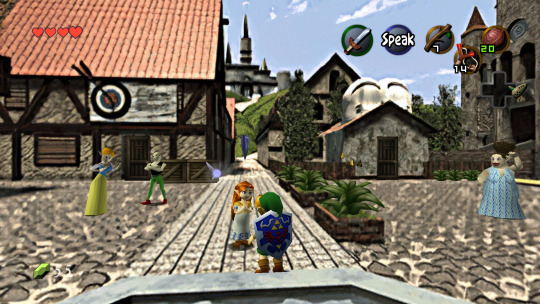
After the Deku Tree, we get a significant gap until the next dungeon as the game opens up to a large expansive world, a technique still used in games today. You’ll be directed towards the castle by a really annoying owl (with confusing did you not hear me or did you not not hear me? yes or no questions), but the size of Hyrule Field is specifically designed that (without knowing the way and rolling to move faster) night will fall, a way to introduce how time works in the game, and how it moves in certain areas.

Castle Town is filled with NPCs to talk to and side quests that are hinted at for you to start later on – although first is the obligatory stealth section, but with a fixed camera to make it easier (was Ocarina of Time the start of the forced stealth section trend?), where you’ll meet Zelda as you learn the quest of the game. Once the “main” quest starts, you need to start figuring out things yourself, with the first big hurdle figuring out what to actually do in Goron City, which is likely where a lot of kids got stuck for a while, as the solution lies in revisiting somewhere across the map.

Dodongo’s Cavern waits to introduce its name until you reach the main central room. Here you can see a lot of paths, both on the current level and upstairs, but this guides you far less than the deku tree as you have to figure out how to navigate the dungeon yourself. It also presents an added danger as your deku shield can be destroyed by fire enemies – you are no longer in a kid’s world, and this dungeon does a great job at portraying that.

After this, you have access to even more of the world, as you’re directed to Zora’s Domain. You also get introduced to magic beans, which let you plant in patches of soft dirt – they’ll take years to grow, so this is the first in-game hint as to what will happen later on. Zora’s Domain also teaches you about bottles (although if you do side missions, you can get some before here), which are used to collect certain items for later on, as well as letting you carry a fairy to revive Link. You also need to go to Lake Hylia, where you can find the wonderful fishing minigame.

After solving the puzzle to get inside Lord Jabu-Jabu, you enter the next dungeon with pulsating walls and dangerous electric jellyfish. This one is very difficult to navigate first time round, and you have to use Ruto to activate switches as she accompanies you for part of this dungeon – a concept revisited in Wind Waker. I like the style of this dungeon, but it’s definitely my least favourite.

With all three spiritual stones in hand, you head to the Temple of Time – grabbing the Ocarina of Time from the fleeing Princess Zelda along the way as Link gets hold of the Master Sword, only to wake up after 7 years in slumber. He’s now an adult, and the world outside is much darker, with a destroyed Hyrule Market overrun by Zombies. A mysterious new character, Shiek, is on hand to guide Link towards the temples he needs to visit to awaken the sages of the land.
You get directed to Kakariko Village, where you need to use clues given by NPCs to find one of the coolest objects in the game – the hookshot.
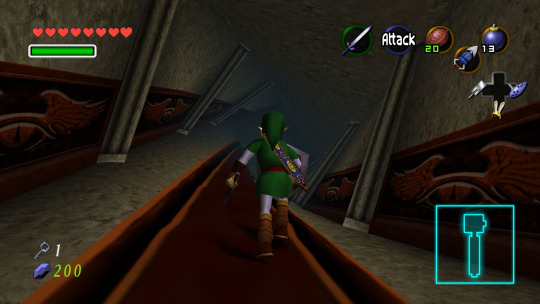
The Forest Temple is the first dungeon as an adult, and has some very unnerving music (the music is amazing across the entire game) and some really neat ideas of manipulating the dungeon itself – something else that would be revisited in more detail in future Zelda games. Here you get the adult equivalent of the slingshot, the bow and arrow. It’s a very unnerving dungeon, and ends with a practice for the final boss of the game.

You can do the temples in different orders, although some optional areas may be locked off – the map for the fire temple, for example, needs the bow. The fire temple also needs a special tunic that you need to get first (although people have completed the dungeon without it), here you get the Megaton Hammer, which is used to activate rusty switches and smash harder rocks, before fighting a fire-breathing dragon. I like to use the Giant’s Knife here, which is a powerful sword that can only last a few hits (a permanent one is a reward for one of the longer side quests of the game).
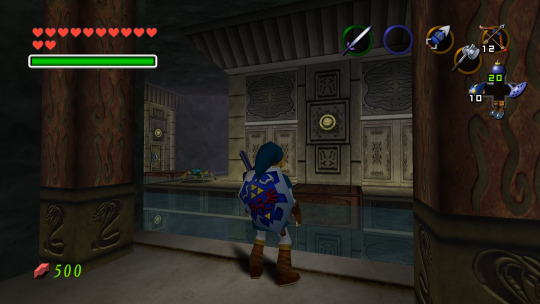
The Water Temple has a really bad reputation, and I can see why. It’s not as outrageously hard as its reputation, but it does a few things differently. The biggest difference is how it treats small keys. Usually they’re on the way to close to the locked door they’re needed for, but the Water Temple is a bit more open ended, with keys hidden all over the place. One in particular (under the central room) is very easy to miss. You also need to change the water level a lot, so exploring it can be a faff. Lastly, the iron boots needed to be constantly equipped and removed, and could only be done so from the pause menu (luckily the version I played, like the 3DS version, lets you assign it to an item button).

Eventually, you’ll be unable to progress as adult Link and will have to return to the past as child Link – something alluded to by the man in the Windmill complaining about someone playing a song on the ocarina in the past (and then teaching you the song, which you will then teach him in the past). The game ups the horror vibes a lot and, if you wait until this point to go back in time and head to the well, you’ll also feel much more vulnerable due to not having access to a lot of your items. This is to get the Lens of Truth, needed for the Shadow Temple (technically you can do it without, but you need to know the game extremely well).
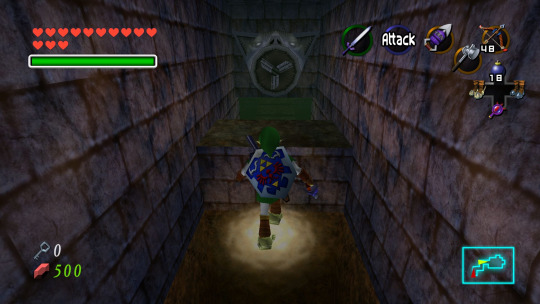
With lots of creepy vibes and invisible enemies and objects, the Shadow Temple really freaked me out as a kid – to the point that I backed out after getting the hover boots and did the Spirit Temple, and I even stopped playing the game, only returning after completing Majora’s Mask years later. It seems really tame now as I know what to expect, but the unknown really was too much for me back then. This temple – and the next – are much more linear, although with really fun bosses.

The Spirit Temple is fascinating as it needs to be completed in two parts – one half as a kid and the other as an adult. You get a really nice shield which is used to reflect light and certain attacks and, like a few other items from the adult dungeons, it’s a shame it doesn’t have much use elsewhere in the game.
After this, you then have access to the final dungeon, which consists of mini challenges loosely based on the various temples, before you take on Ganondorf. Of course, there are still side quests to complete.
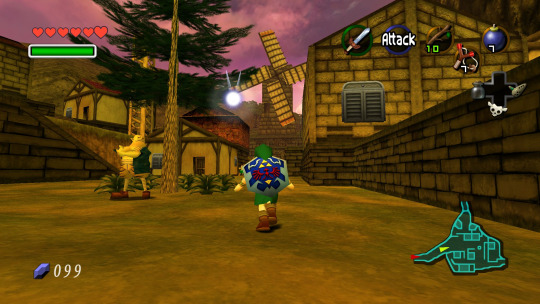
The hunt for heart pieces is the most significant kind of collectible, but the trading and mask side quests are also great. Hidden throughout the land are also 100 Gold Skulltulas, many of which only appear at night. The rewards for the first 50 are pretty good: bigger wallets, a heart piece and a special stone that rumbles when you’re near a secret. The final 50 only grants you 200 rupees which, while you can collect it multiple times, is completely pointless at that point in the game as you’ll spend most of the game with a full wallet anyway. A gold coloured tunic would have been a better option (perhaps it can have protection for fire and water so you don’t need to change tunics).
The lack of things to use money for is probably one of the bigger weaknesses of the game. The dungeons and overworld have bonus puzzles, most leading to money or the Gold Skulltulas. It feels like a waste when the reward you get is completely pointless, but that’s only a minor issue.
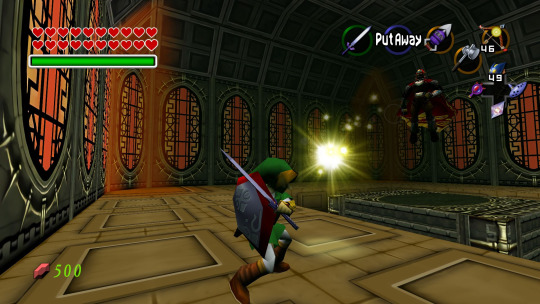
Ocarina of Time is still a wonderful game. The world does feel a bit small by today’s standards, but for its time, it was phenomenal, and in many ways, Ocarina of Time showed how 3D adventures could and should be done. It’s an important piece of video game history that is still great to play today.
Remake or remaster?
Something similar to what the fan PC port offers would be lovely for Ocarina of Time, combined with some of the enhancements of the 3DS version.
Official Ways to get the game
There is no way to buy a new copy of The Legend of Zelda: Ocarina of Time, the only official way to play is to rent it via the Nintendo Switch Online + Expansion Pak.
5 notes
·
View notes
Text
Common Skincare Mistakes and How to Avoid Them for Healthy Skin
Introduction:
Greetings, fellow seekers of luminous skin! Today, we embark on a journey through the intricate landscape of skincare, unraveling the secrets to a radiant complexion. Our pursuit? To understand and sidestep the common skincare missteps that often hinder the path to healthy, glowing skin. Join me as we navigate this adventure towards skincare mastery.

Overlooking Skin Type:
Our skin, a canvas with its own unique texture and composition, deserves a personalized touch. The mistake many make is a one-size-fits-all approach to skincare, overlooking the importance of understanding individual skin types. To avoid this pitfall, take a moment to decode your skin's language—whether it's expressing oiliness, dryness, a combination of both, or sensitivity. Tailoring your products to this unique symphony will set the stage for skincare success.
Inconsistent Cleansing Habits:
Picture cleansing as the gentle overture that sets the tone for your skincare symphony. The common mistake? Inconsistent or improper cleansing, disrupting the rhythm of your skin's daily performance. To stay on the right note, establish a harmonious cleansing routine, choosing a cleanser that resonates with your skin. Take your time, and let each cleanse be a nurturing embrace for your skin.

Skipping Sunscreen:
In the grand ballet of skincare, sunscreen takes center stage as the principal dancer, protecting your skin from the harsh sun's rays. The mistake? Neglecting this essential step or opting for insufficient protection. To choreograph your sun care routine effectively, make applying sunscreen a daily ritual, selecting a partner with at least SPF 30. Allow your skin to bask in the protective glow of this vital performer.
Excessive Exfoliation:
Exfoliation, a dance of renewal for the skin, can turn into a chaotic performance if not handled with care. The mistake is overindulgence, leading to irritation and sensitivity. To maintain a graceful exfoliation routine, follow a balanced schedule, and choose products that align with your skin's natural tempo. Let it be a waltz, not a vigorous tango.
Ignoring Moisturization:
Moisturization, the ballad that keeps your skin's melody harmonious, is often underestimated. The mistake? Thinking that oily skin doesn't need hydration. In truth, every skin type craves moisture. Select a moisturizer that resonates with your skin's unique rhythm, creating a soothing and uplifting symphony.
Not Removing Makeup Before Bed:
Imagine bedtime as the interlude for your skin's nightly rejuvenation, and makeup removal as the prelude to this serene composition. The mistake? Sleeping with the remnants of the day on your skin. To compose a restful night for your skin, make thorough makeup removal a nightly ritual. Allow your skin to breathe freely, unburdened by the traces of the day.

Using Too Many Products:
In the grand orchestration of skincare, less can indeed be more. The mistake lies in overloading your routine with numerous products, creating a cacophony rather than a symphony. To conduct your skincare routine with grace, simplify your regimen, focusing on the essentials. Introduce new products gradually, allowing your skin to adapt and find its rhythm.
Picking at Skin Imperfections:
Resist the urge to engage in a solo performance of dermatology. Picking at skin imperfections, much like playing an unsolicited encore, can lead to more harm than good. To avoid this mistake, discover alternative methods for managing blemishes. Let your skin heal naturally, a process that unfolds like a melodic progression.
Not Paying Attention to Diet and Hydration:
Skincare transcends external care; it is a holistic symphony that includes nourishment from within. The mistake? Overlooking the connection between diet and skin health. To compose a masterpiece of skin wellness, maintain a balanced diet, stay hydrated, and indulge in foods that offer a symphony of skin-friendly nutrients.
Frequently Asked Questions (FAQs):
What are the signs of using the wrong skincare products?
Look out for redness, irritation, breakouts, or a feeling of tightness. Your skin is telling you it's time for a change.
How often should I change my skincare routine?
Allow your skincare routine to crescendo for at least a month before considering changes. Like any grand performance, it takes time to see results.
Can I skip sunscreen on cloudy days?
Never underestimate the persistence of the sun. Clouds may play hide-and-seek, but UV rays can still reach you. Sunscreen is your daily guardian, come rain or shine.
Is it necessary to use a separate night cream?
While not obligatory, night creams are the nocturnal serenades designed for your skin's rejuvenation. Consider adding one to your nightly repertoire for an extra touch of pampering.
How long does it take to see improvements in the skin?
Patience, dear reader, is the silent maestro of skincare. Allow a few weeks for the melody of consistency to weave its enchanting spell.
Conclusion:
In our quest for skin radiance, let us be mindful of the delicate dance that skincare entails. By avoiding these common pitfalls, embracing a consistent routine, and treating our skin with the tender care it deserves, we open the doors to a healthier, more luminous complexion. Your skin is a unique symphony—nurture it, and let its natural radiance shine through the notes of self-love and care!
2 notes
·
View notes
Text
Grow Mallow Plant With Expert Advice

Have you ever wanted a lively, vibrant garden to spruce up your yard and make your outdoor space complete? Few plants provide the splash of color and unique texture that mallow plants do. Dubbed as “malva” by ancient Greeks, they are known for their velvety flowers, leafy foliage, and delicious tasting fruit. Now, with the experts’ advice, you can easily learn how to grow mallow plants and add a splash of eye-catching beauty into your garden! Grow Mallow Plant With Expert Advice body { font-family: Arial, sans-serif; line-height: 1.6; margin: 0; padding: 20px; } h2 { font-size: 24px; margin-bottom: 10px; } h3 { font-size: 20px; margin-bottom: 5px; } p { font-size: 16px; margin-bottom: 10px; } ul { list-style-type: disc; margin-left: 20px; margin-bottom: 10px; } li { margin-bottom: 5px; } blockquote { margin: 0; padding: 10px; background-color: #f9f9f9; border-left: 4px solid #ccc; }
Grow Mallow Plant With Expert Advice
Have you ever wished for a charming plant that not only adds beauty to your garden but also offers a range of medicinal benefits? Well then, the Mallow plant might just be your new horticultural best friend! This delightful perennial herbaceous plant is often overlooked, but today, we're here to give it the recognition it deserves.
The Marvelous Mallow
With its vibrant flowers and lush foliage, the Mallow plant (Malva spp.) is a sight to behold. This hardy plant comes in various species, including the Common Mallow (Malva sylvestris) and the Marsh Mallow (Althaea officinalis), both of which have been traditionally used for medicinal purposes.
"Growing a Mallow plant is like having a loyal friend who is both beautiful and useful."
So, why should you consider growing a Mallow plant in your garden? Well, besides its aesthetic appeal, the Mallow plant has a multitude of benefits. From soothing irritated skin to providing relief for digestive issues, this plant is truly a hidden gem in the world of herbs.
Planting and Care Tips
If you're ready to embark on a journey of growing your own Mallow plant, here are some expert tips to ensure success:
Choose the right location: Mallow plants thrive in well-drained soil and prefer full sun or partial shade.
Sow the seeds: Start by sowing the seeds directly into the soil after the last frost date in your area. Make sure to space them about 12-18 inches apart.
Watering: Keep the soil moist but not waterlogged. Avoid overwatering as it can lead to root rot.
Fertilization: Apply a balanced organic fertilizer during the growing season to promote healthy growth.
Pruning: Regularly prune your Mallow plant to encourage bushier growth and remove any dead or diseased parts.
Medicinal Uses of Mallow
Now, let's dive into the fascinating world of Mallow's medicinal properties:
Soothing Skin Salve: The leaves and flowers of the Mallow plant can be used to create a soothing salve for skin irritations, burns, and insect bites. Simply crush the leaves and mix them with a carrier oil like coconut oil.
Respiratory Relief: Mallow has natural expectorant properties, making it a great herb for relieving coughs, colds, and sore throats. Prepare a herbal tea by steeping the dried leaves in hot water for 10-15 minutes.
Digestive Aid: Mallow leaves are known for their mucilage content, which helps soothe and protect the digestive tract. Prepare an infusion by pouring boiling water over the dried leaves and let it steep for 15-20 minutes.
A Plant Worth Cultivating
There you have it! The Mallow plant is not only a beautiful addition to any garden but also a valuable herbal remedy waiting to be explored. Its versatile nature and numerous health benefits make it a plant worth cultivating.
So, why not give this charming plant a chance to shine in your garden? Not only will it provide you with a sense of accomplishment, but it will also be your very own natural pharmacy right outside your doorstep.
Remember, gardening is a delightful journey of trial and error, so don't be afraid to experiment and learn from your plants. Happy gardening!
Disclaimer: The information provided in this article is for educational purposes only and does not replace professional medical advice. Please consult with a healthcare professional before using any herbal remedies. Learn more about gardening with Taim.io!
2 notes
·
View notes
Text
Drum Kit Accessories to Perfect Your Setup
When it comes to drumming, the core set of drums and cymbals is only the beginning. A well-curated selection of drum kit accessories can make a significant difference in sound quality, performance comfort, and overall playing experience. Whether you're a beginner building your first setup or a seasoned drummer refining your kit, the right accessories transform an ordinary kit into a personalized musical powerhouse.

This article delves into the most essential and underrated drum kit accessories that every drummer should consider — all designed to elevate your sound, improve ergonomics, and enhance durability.
Essential Drum Kit Accessories Every Drummer Should Own
1. Drum Thrones
Often underestimated, a quality drum throne offers the support needed for long sessions. A good throne prevents lower back strain, encourages proper posture, and enhances your ability to move freely. Look for one with adjustable height, memory foam padding, and sturdy base construction.
2. Drumsticks and Stick Holders
Different genres and playing styles require specific sticks. While 5A and 5B are common sizes, jazz drummers may prefer thinner sticks, and metal drummers might need heavier ones. Stick holders, attached to the drum stand, ensure you never miss a beat when a stick breaks mid-performance.
3. Drum Dampeners and Mutes
Controlling overtones and ring is critical for clean sound. Gel dampeners, O-rings, and internal muffling systems can help tailor your drum tone for studio or live settings. Mutes, on the other hand, are ideal for quiet practice without compromising on feel.
Accessories for Better Sound and Maintenance
4. Drum Tuners
A reliable drum tuner takes the guesswork out of achieving pitch-perfect tuning. From digital tuners to mechanical tuning keys, these tools are invaluable for consistent sound across sessions. They are especially useful when playing in venues with varying acoustics.
5. Drum Mats and Rug Anchors
Keeping your kit in place is crucial during intense playing. A dedicated drum mat prevents slipping and protects floor surfaces. Paired with rug anchors, it ensures your bass drum stays firmly in place, enhancing your performance stability.
6. Snare Wire Upgrades
Many drummers overlook the snare wires’ influence on tone. Upgrading to higher-quality wires can add crispness, reduce buzz, and deliver a snappier response. Experimenting with different wire counts also helps find a tone tailored to your genre.
Expanding Creativity with Additional Gear
7. Percussion Add-ons
Adding tambourines, cowbells, and auxiliary snare drums allows for creative expression and rhythmic layering. These drum kit accessories are commonly used in live settings and recording sessions to add texture and depth.
8. Electronic Drum Pads and Triggers
Blending acoustic and digital drumming is a growing trend. Electronic pads allow you to incorporate sampled sounds and loops, while triggers enhance live performances by layering electronic sounds over acoustic hits.
9. Cymbal Felts, Sleeves, and Wing Nuts
These small components protect your cymbals from keyholing and damage. Always ensure cymbals are mounted properly with felt washers, plastic sleeves, and secure wing nuts to extend their lifespan and ensure clean sound.
Finding the Right Accessories at the Right Place
Choosing the best drum kit accessories is only part of the equation — sourcing them from a reputable music store is just as important. Knowledgeable staff, wide product variety, and quality assurance make a significant difference in getting the right gear for your needs.
A trusted music store not only provides well-stocked shelves but also valuable guidance and post-purchase support. Whether shopping online or visiting in person, prioritize retailers with clear product descriptions, verified customer reviews, and robust return policies.
Frequently Asked Questions (FAQs)
What are the must-have drum kit accessories for beginners?
Beginners should prioritize a good drum throne, quality drumsticks, a stick holder, and a drum key. These accessories help establish good playing habits and ensure smooth practice sessions.
Can drum accessories improve my playing?
Absolutely. Accessories such as dampeners, drum tuners, and ergonomic hardware not only enhance sound but also improve comfort and reduce fatigue, allowing you to focus on technique.
How often should I replace my drum kit accessories?
It depends on usage and quality. Drumsticks may need replacing every few weeks, while thrones and hardware can last for years if properly maintained. Regular inspection ensures everything stays in top shape.
Are electronic drum pads suitable for acoustic kits?
Yes, they can be integrated seamlessly. They expand your sonic palette without requiring a full electronic setup and are commonly used by hybrid drummers in modern music.

Conclusion
Perfecting your drum setup is a continuous journey of discovery and refinement. Investing in high-quality drum kit accessories is a smart way to elevate your performance, whether in the studio, on stage, or during casual practice. From comfort-enhancing thrones to sound-shaping dampeners, every detail counts. For the best results, source your gear from a trusted music store that offers expert advice and top-notch equipment tailored to your style.
A well-accessorized kit isn't just about having more gear — it's about creating a responsive, comfortable, and inspiring setup that fuels creativity and supports long-term growth as a musician.
#drum accessories#drum kit accessories#drum parts#drum parts in Australia#guitars online in Australia#music store#online music store#music store Melbourne
0 notes
Text
Elegant Flooring Choices: Exploring Unique Carpet Solutions for Every Space in Dubai

When it comes to designing interior spaces that balance functionality and aesthetic appeal, the role of carpets cannot be overlooked. Whether it’s for a modern apartment, a traditional villa, or a commercial space, choosing the right carpet makes a significant impact. The texture, material, shape, and placement of a carpet are just as crucial as its color or pattern. In Dubai, where both residential and corporate interiors showcase a blend of sophistication and practicality, carpets offer an excellent flooring option.
Among the many available choices, there has been a growing interest in custom and purpose-specific carpets. This includes round carpets for specific design aesthetics, sisal carpets for natural texture lovers, and stair carpets that not only improve safety but also elevate visual appeal. From soft underfoot comfort to visual balance in décor, each category has something to offer.
The Allure of Round Carpets in Modern Interiors
Interior design has embraced symmetry and minimalism, but at the same time, organic shapes and curves are making a comeback. A round carpet can soften the sharp lines in a room, offering a central focal point and encouraging a more relaxed ambiance. Whether used under a coffee table, at the foot of a bed, or in a cozy reading nook, round carpets serve both decorative and functional purposes.
What’s appealing about affordable round carpet services is the accessibility to bespoke sizing, colors, and finishes that suit various room layouts without straining the budget. For apartments with limited floor space or homes with open layouts, these carpets define areas without building walls. They work well in children’s play zones, small office corners, or even as artistic accents beneath decorative furniture.
In Dubai, where interior preferences often lean towards curated elegance, circular carpets can break the monotony of square and rectangular layouts. They pair well with circular light fixtures, round dining tables, and soft fabric furniture, offering a gentle contrast to angular room features. From wool to jute, and from contemporary patterns to minimalist tones, the versatility of these carpets continues to draw attention from homeowners and designers alike.
Natural Texture with a Touch of Refinement: Sisal Carpets
For those who prefer organic materials and earthy tones, sisal carpets remain a preferred choice. They offer a textured look that not only complements modern interiors but also suits more traditional or rustic designs. Made from the fibers of the agave plant, sisal is known for its durability and natural charm.
One of the key highlights of the best sisal carpet Dubai has to offer is its sustainable nature. It's an eco-conscious option that doesn’t compromise on longevity or functionality. Unlike synthetic alternatives, sisal ages gracefully. Its resistance to wear and its non-toxic composition make it an excellent choice for families with kids or pets.
While some flooring materials fade or lose structure over time, sisal retains its natural beauty. In Dubai’s desert climate, where dust and humidity can be a concern, this type of carpet provides easy maintenance and durability. Regular vacuuming and spot cleaning are generally enough to keep it looking fresh.
Sisal carpets also offer acoustic benefits. Their dense weave helps in absorbing noise, which is a valuable advantage in high-rise apartments or commercial offices where sound control enhances the working or living experience. Their non-slip texture also makes them ideal for high-traffic zones, entrances, and hallways.
Practical Flooring with Style: Stair Carpets
Stairs are often one of the most frequently used parts of a home or office, yet they can be overlooked when planning flooring solutions. Besides functionality and safety, stair carpets add visual cohesion to multi-level spaces. They also serve to reduce the noise of footfall and prevent slipping, especially on wooden or marble stairs.
For those considering affordable stair carpet services, there’s a wide variety of textures, materials, and color schemes to explore. These services offer selections that cater to both aesthetic preferences and the need for durability. Dubai homes often feature grand staircases or tightly spiraled ones, and carpeting these correctly requires precise measurement and design compatibility.
Installing stair carpets is not just about covering steps. It’s about choosing the right weave and backing that can endure daily use while maintaining visual appeal. Low pile or flat weave carpets tend to work better as they are less prone to wear and easier to clean. Moreover, carpets with subtle patterns or two-tone finishes can disguise footprints and minor stains, helping maintain a tidy appearance even with constant use.
In residences with kids or elderly family members, stair carpets significantly reduce the risk of slipping. Offices and commercial spaces also benefit, as they comply with safety norms and improve overall design. The color and material can either make the stairs a standout feature or allow them to flow seamlessly into the rest of the interior.
Coordinating Carpet Designs Across Spaces
While each area in a home or office can be designed with its own character, having carpets that create cohesion is essential for visual balance. A round carpet in the living area can be matched with a similarly colored runner on the stairs, or a sisal rug in the hallway can lead into a round woven piece in the reading room.
Rather than overwhelming the space with bold designs, neutral tones and subtle textures often work best, especially in Dubai interiors where marble, wood, and soft paint tones dominate. Coordinated carpets create a sense of order without appearing monotonous. The key is to allow variation in shape and fiber, but keep a consistent theme in color or weave style.
Soft pastels, beiges, and greys remain popular choices, but bolder colors are gaining popularity for accent areas. Custom-made carpet options allow the flexibility to incorporate personal style, branding colors, or cultural elements into the floor design. This personalization is especially useful in hospitality and office interiors.
Maintaining Carpet Quality in Dubai’s Climate
Dubai’s unique climate requires carpets that can withstand dust, heat, and occasional humidity. Proper maintenance and material choice go hand in hand. Natural fiber carpets like sisal may need occasional conditioning to avoid dryness, while synthetic materials need regular vacuuming to avoid static buildup and dust retention.
Choosing a carpet with the right underlay is also important. It protects the carpet from ground moisture, offers extra cushioning, and prolongs the carpet’s life. For stair carpets, non-slip underlays ensure both safety and stability. For round carpets in frequently used rooms, rotational placement can help avoid wear in one specific spot.
Routine care practices such as weekly vacuuming, immediate stain treatment, and professional cleaning once or twice a year will keep carpets fresh and long-lasting. Some carpet service providers also offer maintenance packages or guidance specific to the material you choose.
The Role of Carpets in Interior Identity
Carpets do more than provide floor coverage. They define space, add comfort, and create visual rhythm in a room. In Dubai, where interior design reflects a mix of cultural heritage and modern aspirations, carpets often bridge that gap beautifully. They carry subtle elements of tradition in weave and material while adapting to the evolving needs of modern layouts.
From welcoming guests at the entrance to offering warmth in personal spaces, carpets are essential in building atmosphere. In commercial settings, they can help reflect the brand’s personality or maintain acoustics. A thoughtfully chosen carpet can bring together all the design elements—furniture, lighting, paint, and décor—into a unified experience.
Where to Explore More Carpet Solutions
To explore a wide variety of carpet textures, shapes, and services including round, sisal, and stair carpets, you can visit Dubai Artificial Grass Online. This platform offers options designed to suit varied budgets, interiors, and functional needs, whether you’re decorating a new home or planning an office renovation.
By consulting with flooring professionals and reviewing samples in real settings, clients can make better choices suited to their space, usage, and aesthetic goals. With options ranging from natural textures to functional designs for safety, every room can benefit from the right carpet solution.
Conclusion
Carpets are more than decorative accessories. They are functional design elements that add warmth, reduce noise, and define areas within a space. Whether you are looking for an elegant circular carpet for your living room, a natural sisal option for your hallway, or a functional stair runner that provides safety, the right choice can make all the difference.
With so many choices available, including affordable round carpet services, natural materials like sisal, and practical stair carpet solutions, finding the perfect fit for your space in Dubai is now more accessible than ever. Focus on your needs, explore your options, and create an interior space that feels complete, comfortable, and uniquely yours.
0 notes
Text
Top Mistakes to Avoid When Buying Caviar

Few luxuries capture the imagination quite like caviar. Its glossy pearls, delicate texture, and briny complexity make it synonymous with celebration and refinement. Yet even seasoned gourmands can stumble when purchasing this prized delicacy—especially if they’re hunting for the best caviar in dubai. Below are the most common pitfalls to sidestep so your next caviar experience is truly unforgettable.
Mistake 1: Ignoring the Source and Species
Not all roe is created equal. Beluga, Osetra, Sevruga, Kaluga, and Siberian each offer distinct flavors, sizes, and hues. Treating them as interchangeable can leave you disappointed or overpaying. Before you buy, research which species suits your palate and occasion. For instance, Beluga’s large, buttery grains shine at intimate dinners, while Osetra’s nuttier profile pairs effortlessly with sparkling wine at larger gatherings. Learn the basics so you know exactly what you’re getting—and paying for.
Mistake 2: Overlooking Freshness and Storage Conditions
Caviar’s delicacy is its greatest strength and weakness. Poor temperature control or prolonged exposure to air can dull its flavor and compromise texture. Always check that tins are stored at –2 °C to 2 °C (28 °F to 36 °F) and that vacuum seals are intact. If buying from a counter, observe how frequently containers are rotated and whether staff handle the product gently with mother‑of‑pearl or wooden spoons. Fresher caviar pops crisply on the tongue; anything mushy or fishy has likely spent too long on display.
Mistake 3: Assuming Higher Price Means Higher Quality
Caviar’s reputation for opulence can lure shoppers into equating cost with excellence. While true rarity does command a premium, factors such as marketing, import duties, and limited‑run packaging can inflate price without improving taste. Compare grades within the same species: look for uniform egg size, a glossy sheen, and minimal liquid in the tin. Sampling before purchasing—when permissible—lets you judge quality on flavor rather than sticker shock.
Mistake 4: Forgetting to Read the Salt Content
The subtle brine that defines fine caviar depends on precise salting, known as “malossol” (literally “little salt”). Excess sodium can overshadow nuance, while too little compromises preservation. Reputable producers list salt percentages, typically between 2.5 % and 4 %. Aim for the lower end if you favor delicate notes; opt higher if you prefer firmer texture and a pronounced sea tang. Developing this awareness helps you choose tins that complement, rather than overpower, your chosen pairings.
Mistake 5: Neglecting Sustainability and Ethical Practices
With wild sturgeon populations under pressure, many connoisseurs now seek farm‑raised alternatives. Reputable aquaculture operations maintain water quality, humane harvesting, and traceable supply chains. Check for certifications from recognized fishery or sustainability bodies. Ethical choices not only protect fragile ecosystems but often deliver cleaner flavors, since controlled environments reduce contaminants and off‑notes in the roe.
Mistake 6: Pairing Poorly at the Table
An exquisite tin can fall flat if served with overpowering accompaniments. Strong onions, heavily seasoned blinis, or aggressively oaked wines can mask subtle aromas. Classic pairings—chilled vodka, dry Champagne, or neutral crème fraîche on soft blini—remain popular because they let the caviar shine. Keep flavors light and textures soft so each bead bursts with its intended complexity.
Mistake 7: Buying Too Much (or Too Little)
Caviar is best enjoyed fresh, ideally within 48 hours once opened. Buying a large tin for a small dinner can lead to waste, while a tiny jar at a big party leaves guests wanting more. A good rule of thumb is 30–50 grams per person for a tasting and 15–20 grams if caviar is just one element of a larger spread. Sizing responsibly maximizes enjoyment and minimizes regret.
Final Thoughts
Avoiding these missteps transforms caviar from daunting splurge to confident pleasure. Whether you plan to buy caviar dubai style for a grand celebration or simply wish to treat yourself on a quiet evening, a little knowledge goes a long way. By paying attention to species, freshness, ethical sourcing, and thoughtful service, you’ll savor each pearl as it was meant to be—an elegant nod to the sea’s finest bounty.
0 notes
Text
AlphaTale Dog bitty
Name: Ardrrier
Species: Boarder Terrier
Rank: Beta/Delta
Size: 12-15 inches tall(Mini),
Personality: Lively, determined, scrappy, sweet-natured, hard-working, tenacious, attentive, quietly emotional
Likes: Digging, working alongside others, cozy napping dens, gentle praise, being helpful, soft food, warm laps, loyalty tests (even if you don’t realize you're taking one)
Dislikes: Being idle too long, feeling underestimated, slippery floors, broken routines, loud conflict, being dismissed or "babied"
Compatibility: Ardrrier bitties are small but never to be overlooked- they are fierce, loyal, and driven by a desire to feel useful. Whether they fall into Beta or Delta roles, they approach their tasks with stubborn enthusiasm. As Betas, they are quick to identify gaps in a pack's energy or routine and will try to fill them, whether that means running errands, offering assistance, or trying (sometimes comically) to "fix" emotional tension by inserting themselves between bitties. They respond well to direction and love having goals, even if small.
Delta Ardrriers bring all their focus to nurturing tasks. While not gentle in the delicate sense, their form of care is direct, efficient, and full of intention. They'll clean up messes no one asked them to, make sure everyone’s fed and accounted for, and then snuggle into your lap with a tiny huff and soft eyes that say, “Job done.”
Despite their energy, Ardrriers are highly compatible with most bitty types, especially those who are emotionally reserved or low-energy. They’re not offended by distance, just determined to quietly make life better. However, they may get frustrated or sulky in chaotic environments where their efforts go unrecognized.
Feeding habits: Ardrrier bitties prefer hearty, practical meals- softened grains, mashed vegetables, mild meats, and thick broths. They enjoy consistency and often eat at the same time every day. While small, they have big appetites and may "squirrel away" snacks in bedding or stash areas if unsupervised. They love treats that feel like a reward for hard work.
Additional info: Built with a terrier's trademark sturdiness, Ardrriers have wiry-textured skeletal plating patterned like tousled fur, usually in brown, rust, tan, and gray tones. Their hands and paws are slightly oversized for their height, designed to mimic digging claws. Their eyes are keen, dark, and always alert- even in rest, they seem to be scanning the room.
Ardrriers walk with a bounce and have a tendency to "hop up" into laps, onto ledges, or into trouble. They're fiercely loyal to caretakers who treat them as equals, not accessories.
Zone: [[Inside]]
In Universe: Caretakers often describe Ardrriers as “the smallest foreman in the house.” Despite their size, they somehow end up running the show- or at least trying to. Bitty owners praise their mix of scrappy independence and affectionate snuggling. They're the type to help clean up after a mess, nudge you toward a water bottle when you're overwhelmed, and then curl up in your hoodie to rest.
Most see Ardrriers as low-maintenance emotionally, but observant caretakers quickly learn that recognition is everything. A compliment, a head pat, or even a murmured "you did good" can completely change their day.
Difficulty: Basic – Intermediate
#adoptable#bitty info#bitty bio#bittybones#basic#intermediate#alphatale#alphatale info#alphatale bitty#beta bitty#delta bitty
0 notes
Text
Head Scarves for Women: Classic, Adaptable, and Quite Useful

How Head Scarves Ended Up on My Radar
I had no intention of adopting a headscarf. To be honest, I didn't even consider it. Then, one day—at random—I noticed someone on the train with a few strands of hair falling out naturally and a lovely, pale blue scarf knotted low around the neck. Nothing overdone. And I remember thinking, wow, that’s elegant without trying too hard. That kind of stuck with me. So I started noticing them more. On Pinterest. In old movies. Even just around the neighborhood. Additionally, the more I examined, the more I understood that Head Scarves for Women had never truly gone out of style. They have simply been quietly awaiting their quiet return in the background.Or maybe they didn’t even need one. And that’s when I decided to try it for myself. No big plan. Just a little experiment.
A Style Statement... But More Than That
Fashion is often thought of as trendy, ephemeral, and seasonal. However, occasionally something emerges that somehow manages to feel both timeless and up to date. That's the general idea of head scarves. I was initially attracted to them because of their style. That's the clear explanation. Something extra, like a splash of color, a touch of texture, or a somewhat enigmatic, vintage vibe, can be added with a scarf. I've seen them worn with fitted jackets, flowy dresses, or just jeans and a t-shirt. Somehow, it always works. However, after I began wearing them, I discovered a whole new level of usefulness that I had overlooked. A scarf helps me seem put together on days when I don't feel like styling my hair, whether it's frizzy, oily, or just generally uncooperative. And more than that: united. It's similar to applying lipstick without applying a full makeup application.
The Trial-and-Error of Getting It Right
Let me be clear—head scarves look easy. They’re not always. Not at first. It's a bit of an art to tie a scarf so it remains in place and looks nice. I must admit that there were mornings when I tried wrapping it three or four times and still felt that something wasn't quite right.Too tight. Too poofy. Ends sticking out awkwardly. And once, it just slid right off in the middle of a walk. Not my finest moment. But after a week or so, I started getting the hang of it. You begin to figure out what materials work best for your hair type, what size gives you enough fabric to play with, and which tying methods suit your style. Personally, I found that a light cotton scarf around 25–30 inches square was the sweet spot.It draped well yet had enough hold to hold in place. It can be wrapped like a turban, knotted retro-style under the chin, twisted into a headband, or simply tied loosely behind the neck. More than I'd care to confess, YouTube tutorials were helpful. But also, experimenting in front of the mirror taught me what felt right for me—which is maybe the most important part.
A World of Materials, Colors, and Unexpected Choices
I had no idea how important the content would be until I started this. Without a doubt, silk scarves are elegant—they glide exquisitely and have gorgeous prints—but they can slip easily, particularly if your hair is smooth. A little more traction is provided by cotton or chiffon. Jersey is soft and stretchy, great for longer wraps. And the designs? That was half the fun. I picked up a soft ivory scarf with a delicate floral print—feminine without being too busy. Then a bold, mustard yellow one that I thought would be too much... but turned out to be my favorite. Funny how that happens. I'll admit that sometimes choose which option to wear feels like a ritual, even if I keep a few options folded nicely in a drawer. A silent moment that lends a sense of purpose to the remainder of the day.
Beyond Style: Tradition, Selfhood, and Deference
It is impossible to discuss women's head scarves without recognizing their wider significance. Head scarves are more than just accessories for many women worldwide; they are symbols of identity, culture, modesty, and religion.In some cases, resistance. In others, reverence. They carry weight. I try to treat things with respect because I wear them only for style or functionality. It's simple to become engrossed in the style and overlook the underlying cultural significance of these items. However, I believe that one may have a genuine appreciation for something while still understanding its origins.I try, at least. That said, I also think the beauty of head scarves lies in how they adapt. They can be traditional, modern, casual, ceremonial. They can be ceremonial, informal, modern, or traditional. They have a variety of meanings for different people, which contributes to their enduring appeal.
Hair Maintenance and Unexpected Advantages
I was surprised to learn that wearing head scarves has actually improved my hair. Even though my hair doesn't require a lot of upkeep, I've noticed that using a scarf made of a softer fabric has reduced knots, dryness, and breakage at the ends. Satin scarves are used overnight by some ladies to keep moisture and lessen friction.I’ve tried that a few times, and while I can’t say the results were dramatic, I did wake up with fewer frizzy patches. Maybe it’s psychosomatic. Maybe not. Either way, it’s added another layer of usefulness I didn’t count on.
So... Are Head Scarves for You?
Here’s where it gets a bit fuzzy. I can’t say everyone needs to go out and buy a head scarf. They’re not a must-have. They won’t magically change your routine.But what if you're even slightly interested? Maybe give it a shot if you've ever glanced at one and wondered, "Hmm, could I pull that off?" Because it became more than just a fashion statement for me.. It became a habit. A little ritual. A way to make rough mornings smoother or plain outfits a bit more interesting. Not every day, of course. But enough that I’ve come to appreciate the small power these scarves hold. They're simple, yes. But they offer a kind of quiet confidence I didn’t expect. Read the full article
1 note
·
View note
Text
Top Interior Design Tips from Experts in Bangalore
Bangalore, a city known for its innovation, urban lifestyle, and growing residential spaces, has become a vibrant ground for unique interior design. As modern homeowners seek both comfort and elegance in their living environments, the demand for functional, beautiful, and thoughtfully planned interiors is rising. Many turn to the best interior designers in Bangalore to help create homes that reflect their personalities while maximizing space, light, and efficiency.
Drawing insights from seasoned professionals and home interior designers in Bangalore, this blog shares top tips to help you make smart design decisions and bring out the best in your space—whether you're revamping a small apartment or designing your dream villa.
1. Understand Your Space Before Designing It
Expert designers always begin by studying the space they’re working with. Factors like room size, layout, natural light, and ventilation play a major role in how a space is designed. Avoid overcrowding your rooms and ensure that there’s enough circulation area.
💡 Pro Tip: Use multifunctional furniture and smart layouts to make the most of compact Bangalore apartments.
2. Balance Aesthetics and Functionality
A beautiful home should also be livable. Experts recommend finding the right balance between looks and usability. Prioritize pieces that serve a dual purpose—like a stylish coffee table with storage or a sleek study desk that folds away.
A functional space is often more comforting and practical for daily living, especially in Bangalore’s fast-paced environment.
3. Choose a Cohesive Color Palette
Color sets the mood of your space. Designers in Bangalore often recommend warm neutrals, earth tones, or soft pastels for smaller spaces, as they create an open, airy feeling. If you love bold colors, use them as accents—on cushions, rugs, or feature walls—to avoid visual overload.
💡 Pro Tip: Stick to 2–3 main colors throughout your home for a cohesive and polished look.
4. Use Natural Light to Your Advantage
Natural lighting is a key element in home design. Bangalore’s weather supports plenty of daylight, and designers suggest maximizing it with large windows, light curtains, and reflective surfaces like mirrors or glass furniture.
Well-lit homes not only feel more spacious but also contribute to positive energy and lower electricity usage.
5. Invest in Smart Storage Solutions
Clutter-free homes are more relaxing and easier to maintain. Home interior designers in Bangalore recommend built-in wardrobes, under-bed drawers, vertical shelving, and modular kitchen cabinets to make every inch count.
Design your storage early in the planning phase so it blends seamlessly with your interiors instead of looking like an afterthought.
6. Mix Textures and Materials
Combining different materials—like wood, glass, metal, and stone—adds richness and depth to your interiors. Don’t be afraid to mix soft fabrics with raw finishes or vintage décor with modern furniture. It gives the space character and prevents it from feeling flat.
💡 Pro Tip: Use contrast wisely—pair rough stone walls with smooth marble floors or matte finishes with glossy accents.
7. Highlight a Focal Point in Every Room
Whether it's a striking piece of art, a feature wall, or a designer light fixture, having one focal point draws attention and adds personality. Experts suggest that each room should have at least one element that reflects your style and creates visual interest.
This approach brings a sense of intentional design to your home.
8. Don’t Overlook Lighting Design
Lighting isn't just functional—it’s a design element. Layered lighting that combines ambient (general), task (functional), and accent (decorative) lights can completely change how a room looks and feels.
In Bangalore homes, warm white lighting is preferred for living spaces, while brighter white light works well in kitchens and work zones.
9. Incorporate Greenery and Natural Elements
Indoor plants are an easy way to make your home feel fresh and welcoming. They also improve air quality and add a calming touch to your interiors. Use a mix of tall plants, hanging greens, and tabletop planters based on room size and layout.
Natural décor elements like cane, jute, terracotta, or wooden finishes also connect the indoors with nature—something many Bangalore homeowners now prioritize.
10. Customize to Fit Your Lifestyle
Finally, the most important advice from the best interior designers in Bangalore: your home should reflect you. Customization is key. Whether it’s a reading nook, a home office corner, or a cozy balcony retreat—create spaces that match your daily habits and lifestyle needs.
Work with designers who take time to understand your preferences and personalize designs accordingly.
Conclusion
Interior design is more than just decorating—it's about creating environments that support how you live, work, and relax. With the right approach and guidance from the best interior designers in Bangalore, your space can be transformed into a perfect blend of functionality, style, and comfort.
If you're planning to upgrade your space or build it from scratch, working with professional home interior designers in Bangalore can ensure that every corner of your home is thoughtfully designed and beautifully executed. Their expert advice can save you time, avoid costly mistakes, and ultimately help you create a home you’ll love for years to come.
0 notes
Text
Building More Than Just Barriers: Why Retaining Walls Are a Smart Addition to Any Outdoor Space

When you picture a garden or landscaped yard, chances are you think of lush greenery, paved walkways, and decorative features. But one of the most practical — and often overlooked — elements in shaping a functional and attractive outdoor area is the retaining wall. More than just a structure to hold back soil, retaining walls can help manage drainage, prevent erosion, and even increase the usable space on sloped blocks.
In areas with uneven terrain or shifting soil, a well-designed retaining wall may be the difference between a stable backyard and a collapsing garden bed. Whether you're revamping your landscaping or building from scratch, here’s why this element deserves serious consideration — and how working with specialists like retaining walls by Waynes Landscaping can ensure lasting results.
What Are Retaining Walls and What Do They Do?
A retaining wall is a rigid structure built to support soil laterally so that it can be retained at different levels on either side. In other words, it holds back earth that would otherwise collapse or erode.
These structures are essential in:
Sloped properties, where soil needs to be stabilised
Garden bed creation, helping define elevation and borders
Flood or water runoff control, improving drainage
Erosion prevention, especially in clay-heavy or loose soil zones
Outdoor zoning, such as raised entertainment or lawn areas
Retaining walls aren’t just functional — with the right materials and design, they also enhance your landscape’s overall look. Modern solutions include timber sleepers, concrete blocks, natural stone, and even gabion walls filled with rock for a rustic, durable finish.
Why Property Owners Choose Retaining Walls
Here’s why homeowners, builders, and landscapers turn to retaining walls as a structural and aesthetic feature:
Stabilisation: On sloped sites, walls reduce the risk of landslides, washouts, and soil movement.
Increased Flat Space: Walls allow for level areas where you can place lawns, patios, or garden beds.
Improved Drainage: With the right design, retaining systems can manage stormwater efficiently, reducing boggy patches and erosion.
Kerb Appeal: Professionally built walls add symmetry, definition, and a layered look to landscapes.
Added Property Value: A clean, multi-tiered garden with well-built walls may increase visual appeal and usability — key factors in property valuation.
Providers like professional services for retaining walls are known for combining practical layout planning with attractive, cohesive finishes that suit both new builds and long-standing homes.
Common Types of Retaining Wall Materials
Choosing the right material depends on your project size, budget, and visual goals. Some of the most common types include:
1. Timber Sleeper Walls Ideal for small garden projects, these are budget-friendly and fast to install. They offer a warm, natural look but may require treatment to resist decay.
2. Concrete Block Walls Durable and versatile, these are suitable for both straight and curved wall designs. Concrete blocks are popular in suburban landscapes due to their clean finish.
3. Natural Stone Walls Stone adds texture and visual interest, blending well with native gardens. While more labour-intensive, the result is timeless and highly durable.
4. Brick Retaining Walls Brick provides a classic appearance and pairs well with traditional or heritage homes. It’s commonly used in front yard designs where visual impact matters.
5. Gabion Walls These involve wire cages filled with stone and are valued for both their industrial look and strength in flood-prone areas.
For inspiration and visual guides on how different materials look when applied to real backyards, you might browse user-submitted posts on Tumblr’s outdoor design community.
Engineering Considerations: It’s More Than Just Aesthetics
Retaining walls over 1 metre in height (in most council areas) generally require council approval and engineering certification. Even smaller walls must be built with proper drainage and foundation work to prevent bowing, cracking, or collapse.
Some key engineering considerations include:
Wall height and loading: Taller walls bear more pressure and may need reinforcement.
Drainage management: Without proper weep holes or agi pipes, hydrostatic pressure can build up behind the wall.
Soil type: Sandy, clay, or mixed soil types behave differently under load and water exposure.
Foundation depth: A deep, stable footing is critical to wall longevity.
This is why working with specialists like retaining walls by Waynes Landscaping may offer peace of mind. Their experience ensures the design isn’t just visually pleasing, but structurally sound and compliant with local regulations.
Functional Uses Beyond Retaining Soil
Retaining walls aren’t limited to practical applications — they can also define spaces and enhance liveability. Some creative ways to incorporate them into your landscape include:
Tiered garden beds for vegetables or feature plants
Built-in seating walls around firepits or patios
Feature walls with integrated lighting or water features
Steps and access paths within sloped gardens
Raised outdoor zones, such as decks or pool surrounds
Incorporating retaining walls as part of a broader landscape plan opens up opportunities to create structure, flow, and visual balance in outdoor environments.
You’ll find additional inspiration for combining function with form on curated feeds within Tumblr’s architectural landscaping tag, where professionals and DIYers alike showcase inventive uses of hardscape structures.
Maintenance and Longevity
While retaining walls are largely low-maintenance, a few upkeep habits can help them last for decades:
Clear drains and weep holes regularly to prevent water build-up
Inspect for cracks or shifting, particularly after heavy rainfall
Reapply timber sealants every 2–3 years (if using sleepers)
Control surrounding vegetation to reduce root pressure or undermining
Most well-built retaining walls, particularly those made from concrete or stone, may last 20–50 years with minimal maintenance.
Costs to Expect
The price of retaining walls varies greatly depending on:
Wall height and length
Material used
Site access and excavation needs
Structural requirements and council approvals
Basic timber sleeper walls may cost $250–$400 per metre, while more complex stone or concrete walls can reach $600–$1000+ per metre. Always request a detailed site assessment and written quote before proceeding.
Local providers like Waynes Landscaping offer transparent pricing, tailored recommendations, and expert project execution based on years of regional experience.
Final Thoughts
Retaining walls are more than just garden features — they’re engineered solutions that offer both functional benefits and visual impact. From stabilising sloped yards to creating stunning tiered landscapes, they play a foundational role in many outdoor designs.With the support of specialists like retaining walls by Waynes Landscaping, homeowners gain access to structural know-how, material advice, and aesthetic expertise — all in one service. Whether you’re fixing erosion, expanding usable space, or giving your garden a new identity, retaining walls are a worthy investment in both form and function.
0 notes
Text
Curtain Rods Abu Dhabi: Essential Support for Stylish Interiors

When designing or updating your interiors, it’s easy to focus on curtain fabrics, textures, and colors—but often, the component that holds it all together gets overlooked: the curtain rod. Curtain rods Abu Dhabi are more than just functional accessories; they are a key part of window décor that can enhance the beauty and efficiency of your curtain setup.
Whether you’re redecorating a home, outfitting a new apartment, or furnishing an office, selecting the right curtain rod is just as important as choosing the curtains themselves. In Abu Dhabi, where design meets practicality, curtain rods come in a wide range of materials, finishes, and styles to match every need and taste.
Why Curtain Rods Matter
Curtain rods serve both aesthetic and practical purposes. Functionally, they provide the support structure for your curtains, ensuring smooth opening and closing. Visually, they frame your windows and can serve as a design accent that complements your curtains and overall décor.
In Abu Dhabi’s modern and luxury-driven market, homeowners and interior designers alike seek quality rods that combine strength, style, and affordability.
Types of Curtain Rods Available in Abu Dhabi
Classic Rods (Standard Poles): These rods are simple and functional, perfect for everyday use. They come in various finishes like black, silver, gold, and bronze to complement any curtain style.
Decorative Rods: Ideal for living rooms and master bedrooms, decorative rods feature ornate finials and detailed finishes that add a touch of elegance to your window setup.
Extendable Rods: A practical choice for homes with varied window sizes, extendable rods offer flexibility and easy installation without needing custom fittings.
Double Curtain Rods: These rods support both sheer and blackout curtains, allowing for versatile light control and layered styling—perfect for the hot and sunny Abu Dhabi climate.
Motorized Curtain Rods: For high-end homes and smart offices, motorized rods offer convenience and modern functionality. Operated via remote or smart systems, they are ideal for hard-to-reach or large windows.
Materials and Finishes
Curtain rods in Abu Dhabi are available in various materials to suit different needs:
Metal Rods: Durable, sleek, and perfect for both modern and industrial interiors.
Wooden Rods: Warm and classic, ideal for traditional or rustic room themes.
Plastic Rods: Lightweight and affordable, great for light fabrics and temporary installations.
Finishes range from matte black and brushed nickel to gold, chrome, and antique wood, offering something to match every room’s palette.
Choosing the Right Curtain Rod in Abu Dhabi
Measure Your Window Width: Ensure the rod extends beyond the window frame to allow full curtain clearance.
Consider the Curtain Weight: Heavier fabrics require stronger rods and secure brackets.
Match the Room’s Style: Choose a rod design and finish that blends with your room’s interior theme.
Look for Quality Suppliers: In Abu Dhabi, many furniture and home décor stores, including Dragon Mart and local specialty outlets, offer a wide selection with installation support.
Final Thoughts
Curtain rods may seem like a minor detail, but they play a crucial role in both functionality and aesthetics. With the right curtain Abu Dhabi rods in Abu Dhabi, you can elevate your interiors, ensure smooth curtain movement, and complete your window treatment with elegance and stability. Investing in the right rod is a small step that makes a big difference.
0 notes
Text
Best Foods for Baby Brain Development: Fueling Intelligence from the First Bite
Every parent wants their child to grow up smart, healthy, and strong. While love and care lay the foundation, nutrition plays an equally crucial role—especially in the first 1,000 days of life. During this stage, the brain undergoes rapid development, and the right diet can significantly influence your baby’s cognitive performance. In this blog, we explore the best foods for baby brain development, offering parents a scientifically supported guide to nourish their baby's mind.

The Connection Between Food and Brain Growth
The brain grows more rapidly during infancy than at any other time in life. Nearly 80% of a baby’s brain size is developed by the age of two. This growth requires specific nutrients—especially fats, proteins, vitamins, and minerals—that aid in myelination, neurotransmitter activity, and neuroplasticity. Providing the best foods for baby brain development ensures that these vital functions happen smoothly.
Top Brain-Boosting Foods for Babies
Here’s a curated list of the most effective foods to fuel your baby’s brain development:
1. Oatmeal
Oatmeal is packed with complex carbohydrates, fiber, and iron. It provides long-lasting energy to the brain and supports focus and attention.
Related Keywords: brain food for baby breakfast, iron-rich baby cereals, oats for babies
2. Eggs
Eggs are one of the top best foods for baby brain development because they’re rich in choline, a nutrient essential for brain cell production and memory.
Unique Fact: According to a 2020 study by Cornell University, choline not only improves brain function but also helps reduce stress and anxiety markers in infants.
3. Pumpkin Seeds
Small but mighty, pumpkin seeds are rich in zinc and magnesium—both vital for brain signaling and mood regulation. Ground seeds can be mixed into purees or yogurts.
4. Full-Fat Dairy
Full-fat milk, cheese, and yogurt provide high levels of fat and protein necessary for the production of brain tissue and neurotransmitters.
5. Chia Seeds
Chia seeds are a plant-based source of Omega-3 fatty acids. These healthy fats improve brain cell communication and promote emotional regulation in infants.
6. Green Peas
Rich in vitamin K and manganese, green peas aid in neurotransmitter activity and energy metabolism, keeping the brain sharp and alert.
Related Keywords: vitamin K foods for babies, green vegetables baby food, natural brain boosters for infants
7. Carrots
Carrots are high in beta-carotene and vitamin A, which improve blood flow to the brain and promote visual memory.
8. Coconut Oil
Coconut oil contains medium-chain triglycerides (MCTs), which are quickly converted into ketones—a clean and efficient energy source for the brain.
Unique Fact: Unlike glucose, ketones are known to support mitochondrial efficiency and may enhance learning speed in developing infants.
9. Liver (in small quantities)
Though often overlooked, organ meats like chicken liver are rich in iron, vitamin B12, and choline—nutrients vital for brain oxygenation and memory formation.
10. Quinoa
A complete protein, quinoa offers iron, folate, and B-vitamins in one package. Its mild flavor and soft texture make it perfect for baby food.
Feeding Tips to Maximize Brain Benefits
Pair iron-rich foods with vitamin C: This increases iron absorption, which is essential for brain oxygen transport.
Limit sugar and processed snacks: These hinder memory and learning abilities.
Maintain consistency and routine: A predictable mealtime schedule helps regulate mood and brain function.
Unique Brain-Boosting Tip
New Unique Fact: A groundbreaking 2022 study published in Pediatrics International revealed that babies who consumed lutein-rich foods (like eggs and leafy greens) showed better visual and cognitive scores at 12 months. Lutein accumulates in the brain’s cortex and supports decision-making and learning speed.
Frequently Asked Questions (FAQs)
Q1. Which are the absolute best foods for baby brain development? A1. Eggs, fish, chia seeds, oats, and leafy greens consistently rank as the top foods for brain growth.
Q2. Can plant-based foods fully support brain development? A2. Yes, but plant-based diets should be carefully planned to ensure adequate Omega-3s, iron, and B12—nutrients often limited in vegetarian diets.
Q3. How often should I feed brain-boosting foods to my baby? A3. Ideally, include 2–3 brain-healthy foods in your baby’s meals each day for consistent support.
Q4. Are supplements better than real food for brain development? A4. Real, whole foods are always preferable. Supplements should only be used on medical advice when deficiencies are diagnosed.
Q5. What foods should I avoid for brain health? A5. Avoid sugary cereals, processed meats, and artificial food dyes, as they can negatively affect cognition and attention span.

Related High-Volume Keywords to Include:
best baby foods for brain
baby superfoods for intelligence
foods to increase baby IQ
early brain nutrition
how to make baby smarter with food
food for baby memory power
brain building baby meals
Conclusion
Feeding your child the best foods for baby brain development doesn't just nourish their body—it feeds their mind and shapes their potential. From nutrient-rich eggs and leafy greens to whole grains and seeds, each meal can be an opportunity to build a sharper, stronger brain. As parents, what you place on the plate today lays the foundation for your child’s success tomorrow.
0 notes